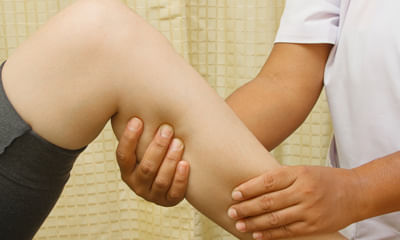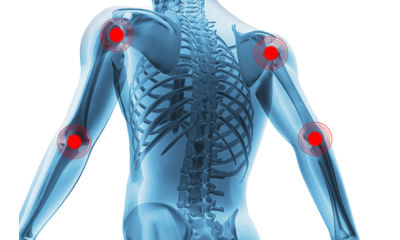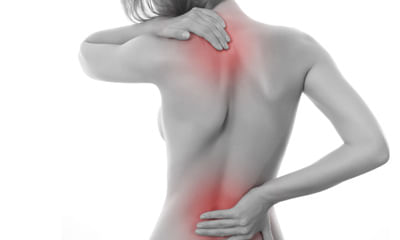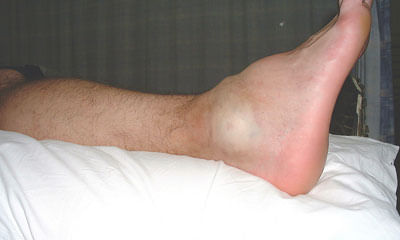Eye Feels Like Sand In It
I went to the caribbean for vacation, while I was there I got some mosquito bites, which isn't surprising, but I also st ...
Ask Free Question
Take tab allegra m bd but do watch out for unexplained fever of other symptoms of tropical diseases like kala azar, malaria, dengue do contact me for further diagnosis and treatment if you feel necessary.
I am experiencing pain in the sole of my left leg, front part of the sole, in the direction of middle (longest) finger. ...
Ask Free Question
To do this exercise: sit up straight in a chair, with the feet flat on the floor. Keeping the toes on the floor, raise the heels. Stop when only the balls of the feet remain on the ground. Hold this position for 5 seconds before lowering the heels. For the second stage, raise the heels and point the toes so that only the tips of the big and second toes are touching the floor. Hold for 5 seconds before lowering. For the third stage, raise the heels and curl the toes inward so that only the tips of the toes are touching the floor. Hold this position for 5 seconds. Build flexibility and mobility by repeating each stage 10 times. 2. Big toe stretch keeping a wide range of motion in the big toe is important. The following exercise also has three stages and is designed to stretch and relieve pain in the toes from wearing tight shoes. To do this exercise: sit up straight in a chair, with the feet flat on the floor. Bring the left foot to rest on the right thigh. Using the fingers, gently stretch the big toe up, down, and to the side. Keep the big toe in each position for 5 seconds. Repeat this 10 times before switching to the other foot. Exercises for strength the following exercises can help enhance the strength of the feet. 3. Toe splay doing the toe splay exercise can improve control over the toe muscles. People can do it on both feet at once or on alternate feet, depending on which they find more comfortable. To do this exercise: sit in a straight backed chair, with the feet gently resting on the floor. Spread the toes apart as far as possible without straining. Hold this position for 5 seconds. Repeat this motion 10 times. Once a person has built up their strength, they can try looping a rubber band around the toes. This will provide resistance and make the exercise more challenging. 4. Toe curls doing toe curls builds up the flexor muscles of the toes and feet, improving overall strength. To do this exercise: sit up straight in a chair, with the feet flat on the floor. Lay a small towel on the floor in front of the body, with the short side facing the feet. Place the toes of one foot on the short side of the towel. Try to grasp the towel between the toes and pull it toward oneself. Repeat this exercise five times before switching to the other foot. To make this exercise more challenging, try weighing down the opposite end of the towel with an object. 5. Marble pickup doing the marble pickup can increase strength in the muscles on the undersides of the feet and toes. To do this exercise: sit up straight in a chair, with the feet flat on the floor. Place an empty bowl and a bowl of 20 marbles on the floor in front of the feet. Using only the toes of one foot, pick up each marble and place it in the empty bowl. Repeat this exercise using the other foot. 6. Sand walking gabriel codarcea / eyeem/getty images walking barefoot on sand is a great way to stretch and strengthen the feet and calves. This is a good exercise in general because sand’s soft texture makes walking more physically demanding. To do this exercise: head to a beach, a desert, a volleyball court, or any other location with sand. Remove the shoes and socks. Walk for as long as possible. Try increasing the distance slowly over time to avoid overexerting the muscles in the feet and calves. Exercises for pain the following exercises can be helpful for pain relief. 7. Toe extension the toe extension is useful in preventing or treating plantar fasciitis, which is a condition that causes pain in the heel when walking and difficulty raising the toes. To do this exercise: sit up straight in a chair, with the feet flat on the floor. Place the left foot on the right thigh. Pull the toes up toward the ankle. There should be a stretching feeling along the bottom of the foot and heel cord. Hold for 10 seconds. Massaging the arch of the foot while stretching will help ease tension and pain. Repeat this exercise 10 times on each foot. 8. Golf ball roll rolling a golf ball under the foot can help relieve discomfort in the arch and ease pain associated with plantar fasciitis. To do this exercise: sit up straight in a chair, with the feet flat on the floor. Place a golf ball — or another small, hard ball — on the floor next to the feet. Lay one foot on the ball and move it around, pressing down as hard as is comfortable. The ball should be massaging the bottom of the foot. Continue for 2 minutes, then repeat using the other foot. A frozen bottle of water can be a soothing alternative if no suitable balls are available. 9. Achilles stretch the achilles tendon is a cord connecting the heel to the calf muscles. It can strain easily, but keeping it strong may help with foot, ankle, or leg pain. To do this exercise: face a wall and raise the arms so that the palms of the hands are resting flat against the wall. Move one foot back, keeping the knee straight. Then, bend the knee of the opposite leg. Keep both the heels flat on the floor. Push the hips forward until there is a stretching feeling in the achilles tendon and calf muscles. Hold for 30 seconds before switching sides. Repeat three times on each side. For a slightly different stretch, bend the back knee and push the hips forward. Foot health and safety tips to help keep the feet strong and healthy: complete a thorough warmup routine before exercising. Wear supportive footwear for day-to-day activities and sports. Replace worn-down shoes as often as possible. Build up strength and flexibility slowly to condition the feet and ankles. Avoid uneven surfaces, especially when running. Try not to run uphill too often. Listen to the body. Do not overdo activities. Prevent any recurrence of injury by resting and seeking appropriate treatment.
Hyy dear sir/mem .i am 21 years old. Sometimes when I sleep at night my left hand become numb. After that I feel little ...
Ask Free Question
This is normal. Just correct your posture of sleeping so that there is no pressure on hands while sleeping. Pressure leads to blockage of blood supply to hand, most of the times it's harmless, but prolonged pressure might damage your nerves due to lack of blood supply. So don't worry for whatever happened till now, just be careful for future.
20 years old female. Feel pain in my 1st metatarsophalangeal joint without any swelling mostly both the legs, currently ...
Ask Free Question
Get your thyroid profile, cbc, blood sugar fasting checked from some lab. In the meanwhile follow this 1. Don't take tea empty stomach. Eat something like a banana (if you are not diabetic) or any seasonal fruit or soaked almonds and a glass of water first thing in the morning (within 10 mins of waking up). No only biscuits or rusk will not do. 2. Don't overeat 3. Take your breakfast every day. Don't skip it. U should eat whatever your mother or grandparent eat in bfast. I mean to say whatever is your traditional food. If punjabi eat paratha, if belongs to south then take idli/ dosa etc. 4. Have light meals every 2 hours (in addition to your breakfast, lunch n dinner) e.g. Nariyal paani, chaach, a handful of dry fruits, a handful of peanuts, any fresh n seasonal fruit, a cup of curd/milk etc 5. Finish your dinner at least 2 hours before going to sleep. 6. Maintain active life style7. Avoid fast foods, spicy n fried foods, carbonated beverages 8. Take a lot of green vegetables n fruit. 9. Drink lot of water.10. Everyday preferably sleep on same time exercise in the form of yoga, cycling, swimming, gym etc.For more details, you can consult me.
Sir, from last 1.5 years, I am suffering from acl sprain in left knee. Initially, I took treatment for around 3 month sa ...
Ask Free Question
1.Don’t take too much rest- not only your body muscles may become weaker even your joint’s pain may become worse. Take consultation from your physiotherapist to guide you with knee pain exercises which are safe for your knees & keep doing it. 2.Do exercise– exercises help in strengthening the muscles, increase flexibility & also support your knee. You can also do swimming, walking, elliptical machines & bicycles, etc. 3.Don’t avoid your weight– excess weight may increase the stress on your knee and if you have inflammatory arthritis then it may become worse. You don’t need to have ideal weight, you just need to start working to reduce the weight. 4.Rice - this process is good for joint pain caused due to minor injury or an arthritis. ••r (rest) – give some rest to your knees. •I (ice) – massage your knees with ice to reduce swelling. •c (compression)- start wearing compression bandage. •e (elevation)- keep your knee elevated. 5.Don’t wear bad shoes- we actively wear shoes in our daily life for hours without noticing how it can affect your knees badly. So, if you are facing knee pain, then check your shoes first. Is it giving you good comfort? If not then change it urgently. The importance of buying braces and splints from us – orthopaedic support braces we suggest you to wear knee brace which is available at our clinic. If you want you can buy from us, if you are far away from chennai we can send you by courier. The reason why we are conveying you to buy from us is we can demonstrate over the videocall (using whatsapp) and also we can monitor you throughout when to wear it and how long to wear it. And also if you find any difficulty wearing the brace you can also revert back to us for few more suggestions and we can propose you good solution how to go about it. Resisted terminal knee extension: make a loop with a piece of elastic tubing by tying a knot in both ends. Close the knot in a door at knee height. Step into the loop with your injured leg so the tubing is around the back of your knee. Lift the other foot off the ground and hold onto a chair for balance, if needed. Bend the knee with tubing about 45 degrees. Slowly straighten your leg, keeping your thigh muscle tight as you do this. Repeat 15 times. Do 2 sets of 15. If you need an easier way to do this, stand on both legs for better support while you do the exercise. Standing calf stretch: stand facing a wall with your hands on the wall at about eye level. Keep as arthritis is very common that you get generally bilaterally. Ice therapy would definitely help to reduce the inflammation. We also advise you to use knee cap which would help to prevent the knee from damaging further and also to maintain the quadriceps muscle tone 1. Heel and calf stretch to do this stretch: 1.Stand facing a wall. 2.Place your hands on the wall and move one foot back as far as you can comfortably. Toes on both feet should be facing forward, heels flat, with a slight bend in your knees. 3.Lean into the stretch and hold for 30 seconds. You should feel the stretch in your back leg. 4.Change legs and repeat. 5.Do this stretch twice for both legs. Short arc quad / isometeric quad exercise the short arc quad exercise is a great way to really focus in on properly contracting your quadriceps muscles. Here is how you do it: lie on your back and use a yoga block or basketball to prop your knee up. Slowly straighten your bent knee until it is all the way straight. Tighten your quad muscle with your toes pointed toward the ceiling and hold it tight for five seconds. Slowly lower your leg down. Repeat for 15 repetitions. Quadriceps, isometric (strength) this exercise is for an injured right knee. Switch sides if the injury is to your left knee. 1.Sit on the floor with your right leg straight in front of you. Bend your left knee up and put your left foot flat on the floor. 2.Flex your right foot and tighten the thigh muscles of your right leg. Press the back of your right knee toward the floor. Don’t arch your back or hunch your shoulders. 3.Hold for 5 to 10 seconds. Then relax. 4.Repeat 10 times, or as instructed. 5.Do this exercise 3 times a day, or as instructed. 2. Quadriceps stretch to do this stretch: 1.Stand next to a wall or use a chair for support. Your feet should be shoulder-width apart. 2.Bend one knee so your foot goes up toward your glutes. 3.Grab your ankle and gently pull it toward your glutes as far as you can comfortably. 4.Hold for 30 seconds. 5.Return to the starting position and change legs. 6.Repeat 2 times on each side. Hamstring stretch •take a break from strenuous activities to allow the injury to heal. •use a cane or crutches to avoiding putting your full weight on your injured leg. •apply ice packs several times a day to relieve pain and reduce swelling. •wrap the injured area with a compression bandage or wear compression shorts to minimize swelling. •rest with your leg elevated above the level of your heart, if possible, to improve drainage and minimize swelling. To do this stretch: to do this stretch: 1.For this stretch, you can use a mat to add cushioning under your back. 2.Lie down on the floor or mat and straighten both legs. Or, if it’s more comfortable, you can bend both knees with your feet flat on the floor. 3.Lift one leg off the floor. 4.Place your hands behind your thigh, but below the knee, and gently pull your knee toward your chest until you feel a slight stretch. This shouldn’t be painful. 5.Hold for 30 seconds. 6.Lower and change legs. 7.Repeat 2 times on each side. Strengthening exercises 5.Half squat to do this exercise: 1.Get into a standing squat position with your feet shoulder-width apart. Place your hands on your hips or out in front of you for balance. 2.Looking straight ahead, slowly squat down about 10 inches. This is the halfway point to a full squat. 3.Pause for a few seconds, then stand up by pushing through your heels. 4.Do 2 to 3 sets of 10 repetitions. 5. Calf raises to do this exercise: 1.Stand with your feet shoulder-width apart. Position yourself next to a wall or hold on to the back of a chair for support. 2.Lift both your heels off the ground so that you’re standing on the balls of your feet. 3.Slowly lower your heels to the starting position. Control is important with this exercise for strengthening your calf muscles. 4.Do 2 to 3 sets of 10 repetitions. 6. Hamstring curl 7. Leg extensions to do this exercise: 1.Sit up tall in a chair. 2.Put your feet flat on the floor, hip-width apart. 3.Look straight ahead, contract your thigh muscles, and extend one leg as high as possible without raising your buttocks off the chair. 4.Pause, then lower to the starting position. 5.Do 2 to 3 sets of 10 repetitions for each leg. 8. Straight leg raises to do this exercise: 1.For this exercise, you can use a mat to add cushioning under your back. 2.Lie down on the floor with one leg bent and one leg straight out in front of you. 3.Contract the quadricep of your straight leg and slowly raise it up off the floor until it’s the same height as your bent knee. 4.Pause at the top for 5 seconds, then lower to the starting position 5.Do 2 to 3 sets of 10 repetitions for each leg. 9. Side leg raises to do this exercise: 1.Lie on your side with your legs stacked on top of each other. Cradle your head in your hand, and place your other hand on the floor in front of you. 2.Raise your top leg as high as you comfortably can. You should feel this on the side of your hips. 3.Pause briefly at the top, then lower your leg. 4.Do 2 to 3 sets of 10 repetitions for each leg. 10. Prone leg raises to do this exercise: 1.For this exercise, you can use a mat to add cushioning beneath you. 2.Lie on your stomach with your legs straight out behind you. You can let your head rest on your arms. 3.Engage your glute and hamstring muscles in your left leg and lift your leg as high as you comfortably can without causing pain. Be sure to keep your pelvic bones on the floor throughout this exercise. 4.Hold your leg in the lifted position for 5 seconds. 5.Lower your leg, rest for 2 seconds, then repeat. 6.Do 2 to 3 sets of 10 repetitions for each leg.
I am diwas sarki I am getting swelling because of burn with plastic in my ankle from last 3 days. ...
Ask Free Question
To treat a swollen ankle or leg at home, remember the acronym rice: rest. Stay off your ankle or leg until you can get to the doctor or until the swelling goes away. Ice. Put ice on the swollen area as soon as you can for 15 to 20 minutes. Then repeat every three to four hours. Compression. Wrap your ankle or leg snugly, but be sure not to cut off circulation. Support stockings may be an option. Elevation. Raise your ankle or leg above your heart (or as far above your heart as possible). Two pillows will usually give you the correct elevation. This encourages fluid to move away from your leg. Medical treatment if you seek medical attention, your physician will likely determine what’s causing your symptoms. Testing may include: blood tests an x-ray an electrocardiogram urinalysis if the swelling is caused by a medical condition such as congestive heart failure, the doctor may prescribe diuretics. These medications affect the kidneys and stimulate them to release fluids. If an ongoing medical condition such as rheumatoid arthritis is the root of the problem, your treatment may turn into management and prevention of that condition. Swelling due to injury may require bone resetting, a cast, or surgery to repair the injured area. For swelling that’s painful, a doctor may prescribe a pain reliever or over-the-counter anti-inflammatory medication, such as ibuprofen (advil) or naproxen sodium (aleve). Mild swelling from pregnancy or a mild injury usually goes away on its own after delivery of the baby or with sufficient rest. After treatment, you should contact your doctor if: your swelling gets worse you have breathing difficulty or chest pain you feel dizzy or faint exercise precautions while you can’t always prevent injuries during physical activity, warming up first can help. This includes a walk or light jog before engaging in vigorous physical activity. Choose supportive footwear. Proper shoes can help correct any gait issues and prevent injuries. You should choose shoes that match your activity or your specific needs. If you jog or run, get fitted by a professional for the correct shoe. Compression socks compression socks apply pressure to your lower leg. In some cases, this can help prevent and alleviate ankle and foot swelling caused by certain conditions, such as: deep vein thrombosis lymphedema varicose veins venous insufficiency you should check with your doctor before using compression socks for your swelling. These special socks should be properly fitted for you and your needs. Also, be sure to wear them during the day and remove them before you go to bed. Leg elevation if you stand a lot during the day, try propping your feet up or soaking them in water when you get home to help prevent swelling. Muscle relaxant: reduces muscle tension and helps relieve muscle pain and discomfort. Transcutaneous electrical nerve stimulation (also known as tens) is something which helps ease muscle pain and spasms. You can strengthen the muscles by doing tonification ie. Improving the tone of the muscles by adding either weight cuffs / sand bags which will help you to improve the strength of the muscles.
So, if I am getting foreign object sensation in my eyes due to some kind of eye problem. Am I supposed to feel that the ...
Ask Free Question
Hello sir. Foreign body sensation is a very common eye condition. It can be objective (with some actual foreign body - an object) or subjective (just a sensation - no object). One has to examine your eyes in details before deciding which category it will lie in. Upper and lower palpebral conjunctiva has to be seen carefully to rule out an organic cause of your fb sensation. If something is there, treatment will be aimed at removing it. Otherwise, if itâs clear, treatment will differ. I am available for consultation to discuss your concerns in further details and advise you a treatment plan. Hope this helps. Thank you.
I get foreign eye sensation in my eyes due to some problem from 6 years. Is it normal that I feel there is something in ...
Ask Free Question
I am sorry to hear about your concern but will be happy to assist you. If a person can feel something in their eye, it is typically an eyelash, some dust, or a grain of sand. However, “foreign body sensation” can cause eye discomfort without there actually being anything in the eye. Dry eyes and inflammation of the eyelids can make it feel as though something is in the eye. Let's connect over a call so that we can discuss your concern in details and make a suitable treatment plan for you.
I have burning sensation after urination. And I feel urge to urinate. I have mild plank pain. I think it's uti very very ...
Ask Free Question
Basant kusumakar ras 1 tablet twice a day gokshuradi avleh 3 gram twice a day get an abdominal ultrasound report.
Why is my tongue dry. And I feel sand like on my tongue and I also feel foot stuck on my throat. ...
Ask Free Question
I am sorry to hear about your concern but will be happy to assist you. Dry mouth can be due to certain health conditions, such as diabetes, stroke, yeast infection (thrush) in your mouth or alzheimer's disease, or due to autoimmune diseases, such as sjogren's syndrome or hiv/aids. Snoring and breathing with your mouth open also can contribute to dry mouth. Tobacco and alcohol use. Let's connect over a call so that we can discuss your concern in details and make a suitable treatment plan for you.








